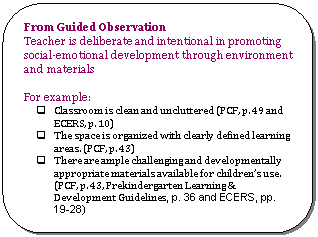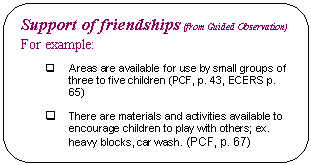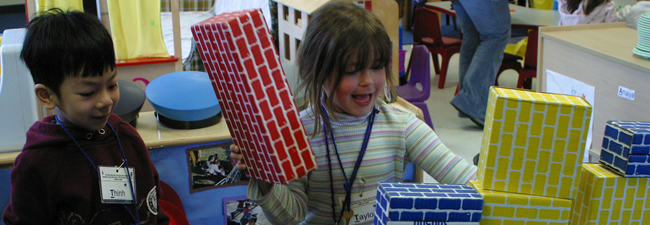Introduction
INTRODUCTION
Providing technical assistance to teachers can sometimes feel overwhelming. Where do you begin? How do you prioritize the areas that you will address? How do you approach professional development so that it is meaningful to teachers?
This trainer’s manual is organized to help you in your work with teachers as they support children’s social emotional growth and development. Guidance from a trainer or mentor can help teachers gain confidence as they develop these skills. This manual is organized
- To help you identify and address specific teacher needs,
- To give you an array of training ideas and strategies from which to choose
- To provide useful information about social emotional resources from both California Department of Education (CDE) documents and outside resources
GUIDED OBSERVATION
The first section in this trainer’s manual, Guided Observation, simplifies the observation process by listing a principle from the Preschool Curriculum Framework and offers concrete examples of what this might look like in a preschool classroom. The guided observation is not intended to be used as a classroom or teacher assessment. Instead, consider it as a guide to assist efforts in supporting teacher practice.
 The principles and examples in the guided observation align with the guiding principles from the California Preschool Curriculum Framework. The principles are listed first and are followed by a few examples of how a principle might be demonstrated. For example, the observation that a teacher is deliberate and intentional in promoting social development through environment and materials, might be reflected in a classroom that is clean and uncluttered, classroom space that is organized with clearly defined learning areas, and ample challenging and developmentally appropriate materials that are available for children’s use. It is important to note that the examples listed are simply examples for each of the principles and that there may be many more ways teachers might demonstrate each principle.
The principles and examples in the guided observation align with the guiding principles from the California Preschool Curriculum Framework. The principles are listed first and are followed by a few examples of how a principle might be demonstrated. For example, the observation that a teacher is deliberate and intentional in promoting social development through environment and materials, might be reflected in a classroom that is clean and uncluttered, classroom space that is organized with clearly defined learning areas, and ample challenging and developmentally appropriate materials that are available for children’s use. It is important to note that the examples listed are simply examples for each of the principles and that there may be many more ways teachers might demonstrate each principle.
References are provided at the end of every example. The abbreviations refer to the resources listed in the CDE Resources section of this trainer’s manual. The cited references are as follows:
- Preschool Curriculum Framework (PCF)
- Preschool Learning Foundations (PLF)
- Early Childhood Environment Rating Scale (ECERS)
- Preschool English Learners Resource Guide (PEL)
- Desired Results Developmental Profile © (DRDP©)
- Learning and Development Guidelines
TOOLBOX
Once a trainer observes teachers and environments using the Guided Observation in this Trainer’s Manual, he/she will have a general idea in which areas teachers might need additional support and/or coaching. The Professional Development Toolbox section of this trainer’s manual offers professional development strategies and ideas for each of the principles listed in the Preschool Curriculum Framework. It is recommended, however, that before using the toolbox, teachers be given the opportunity to conduct a self-evaluation. A self-evaluation tool is available in the Program Guidelines handouts.
From the self-evaluation process teachers will identify their strengths and one or two areas to requiring assistance. Given the insight from the self-evaluation, in addition to classroom observations, the trainer will be able to best identify which coaching strategies/ideas from the toolbox might be most beneficial to the teacher.
Here is an example of what this might look like:
Information Gathered from Observation

Information Gathered from Teacher’s Self-Evaluation
The teacher takes pleasure in that, according to the self-evaluation, she develops respectful and affectionate relationships with children. She takes pride in this area. Using a strength-based approach, you share observations that exemplify support for children’s social and emotional development. Trainer may ask, “Let’s talk about next steps. What would you like to work on?” The teacher shares that she works so much on establishing relationships with children, that she may have missed the importance of helping children form friendships.
Gathering information from conversations and interactions with the teacher, the Guided Observation tool, and the teacher self-evaluation process will help determine which strategies from the toolbox might be most beneficial. In this scenario, the information gathered is that the teacher may need support in (1) understanding the importance of fostering friendships, and (2) implementing actual strategies that encourage children to interact purposefully with one another. Although there are several strategies in the toolbox that address fostering friendships, choosing one or two strategies to begin with is a good idea. The following strategies are from the toolbox and address the area of fostering friendships:
- Look at the room arrangement with the teacher to assess whether there is at least one or more clearly defined places for two or three children to engage in activities that are more complex for extended, uninterrupted periods. Strategize with the teacher to create such spaces as needed. (PCF, p. 83)
- Conduct a classroom walk with the teacher, listing all the materials that promote and encourage peer play, such as heavy blocks, wagons, or a car wash outside. Together, brainstorm additional materials and activities that can be added to the environment. (PCF, p. 67)
RESOURCES
This trainer’s manual has two resource sections. The first section provides a list of CDE resources including the California Preschool Learning Foundations, the California Preschool Curriculum Framework, the Desired Results Developmental Profile© (DRDP©), and outside resources such as the Early Childhood Environment Rating Scale (ECERS). For every resource listed, the sections and/or pages that refer to social emotional growth and development in young children are listed below the resource description.
The second resource section in this training manual includes additional resources such as websites and journal articles that address social emotional growth and development in young children.
Referring to early childhood resources when working with teachers helps them become aware of the research available in the area of social emotional growth and development in young children. It is highly recommended that teachers read the California Preschool Learning Foundations, specifically for understanding typical behaviors and patterns of development for children 48-60 months of age. The California Preschool Curriculum Framework will provide teachers with guidance for planning experiences and classroom environments that not only align with the foundations but also are meaningful for young children, developmentally appropriate, and inclusive of children who speak a language other than English in their home and children with disabilities or other special needs.
